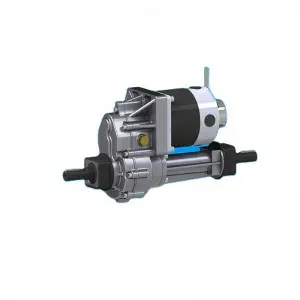How to balance weight reduction and material durability in electric drive shafts
Introduction
In today’s automotive industry, electric drive shafts (electric transaxles) are key components of electric vehicles (EVs), and their design and manufacturing face many challenges. On the one hand, weight reduction is necessary to improve energy efficiency and driving range; on the other hand, material durability is crucial to ensure vehicle safety and reliability.
I. Importance of material selection
(I) Lightweight materials
Aluminum alloys: Aluminum alloys are widely used in the manufacture of electric drive shafts due to their high strength and lightweight properties. For example, aluminum alloy 7075 exhibits higher deformation and stress under static and dynamic conditions, but is lighter and has better vibration resistance.
Carbon fiber reinforced plastic (CFRP): CFRP materials have excellent mechanical strength, corrosion resistance, and low electrical conductivity, and are suitable for internal permanent magnet synchronous motors (IPMSM) in high-speed electric vehicles. Using CFRP wrapped or injection molded rotors can improve torque density and efficiency, but may also increase manufacturing costs and complexity.
High-strength steel: High-strength steel provides the necessary strength and durability while reducing weight to a certain extent.
Titanium alloy: Titanium alloy is an ideal material for high-speed train and electric vehicle drive shafts due to its advantages such as light weight, high strength, corrosion resistance and heat resistance. However, the high cost and processing complexity of titanium alloys remain the main obstacles to its widespread application.
(II) Composite materials
Composites, such as carbon fiber and glass fiber, are increasingly used in electric drive shafts to reduce weight, enhance durability and improve efficiency. These materials help achieve the goals of energy conservation, emission reduction and overall vehicle performance improvement.
II. Optimization design strategy
(I) Use advanced manufacturing technology
Additive Manufacturing (AM): Additive manufacturing technologies, such as Selective Laser Melting (SLM), allow the manufacture of complex three-dimensional structures and optimize the design of components such as motor windings and gears, thereby improving performance and efficiency.
Powder metallurgy: Components manufactured by powder metallurgy, such as gears and bearings, can have a uniform material structure, thereby improving strength and wear resistance.
(ii) Applying Bio-Inspired Algorithms
Bio-inspired algorithms, such as Particle Swarm Optimization (PSO), Ant Lion Optimization (ALO), Continuous Genetic Algorithm (CGA), and Vortex Search Algorithm (VSA), have performed well in the optimization design of electric drive shafts. These algorithms are able to handle complex nonlinear problems and find the design solution that strikes the best balance between weight reduction and durability.
(iii) Performing Detailed Stress Analysis
Static Analysis: Evaluate the deformation, stress, and strain of the drive shaft under different loads. For example, aluminum alloy 7075 performs high in deformation and stress, but is lightweight.
Modal Analysis: Study the natural frequency and modal shape of the drive shaft. The higher natural frequency of aluminum alloy 7075 indicates that it is more resistant to vibration and resonance.
(iv) Optimizing the Design of Gears and Shafts
Gear Design: The gear design of electric drive shafts needs to consider multiple aspects such as power transmission layout, durability, noise, vibration and harshness (NVH), lubrication, and efficiency. Optimizing the micro-geometry of the gears to accommodate the torque range of the electric motor is key to improving durability.
Shaft design: When designing an electric drive shaft, multiple factors need to be considered, including material selection, static analysis, modal analysis, and optimized design. The design results are verified through experiments, and the use of mixed materials is considered to optimize weight, strength, and durability.
3. Optimization of lubrication and cooling systems
(I) Selection of lubricants
Using ultra-low viscosity (ULV) lubricants can improve efficiency while ensuring wear resistance and thermal stability. This helps to maintain the durability of the drive shaft while reducing weight.
(II) Design of cooling system
Improving cooling capacity is key to dealing with the additional heat generated by the electric drive shaft. A good cooling system can prevent overheating, thereby extending the service life of the drive shaft.
Post time: Jul-28-2025


